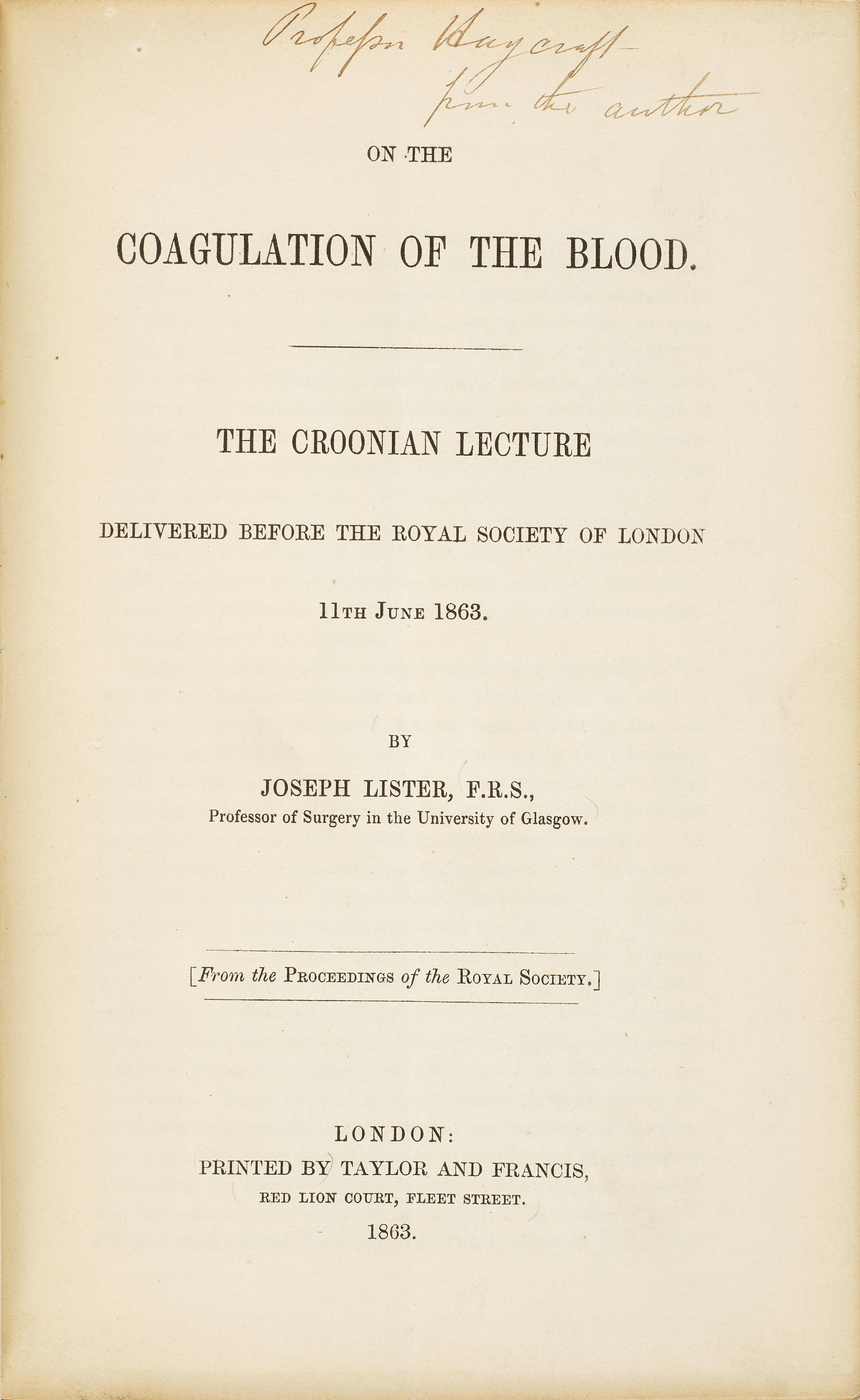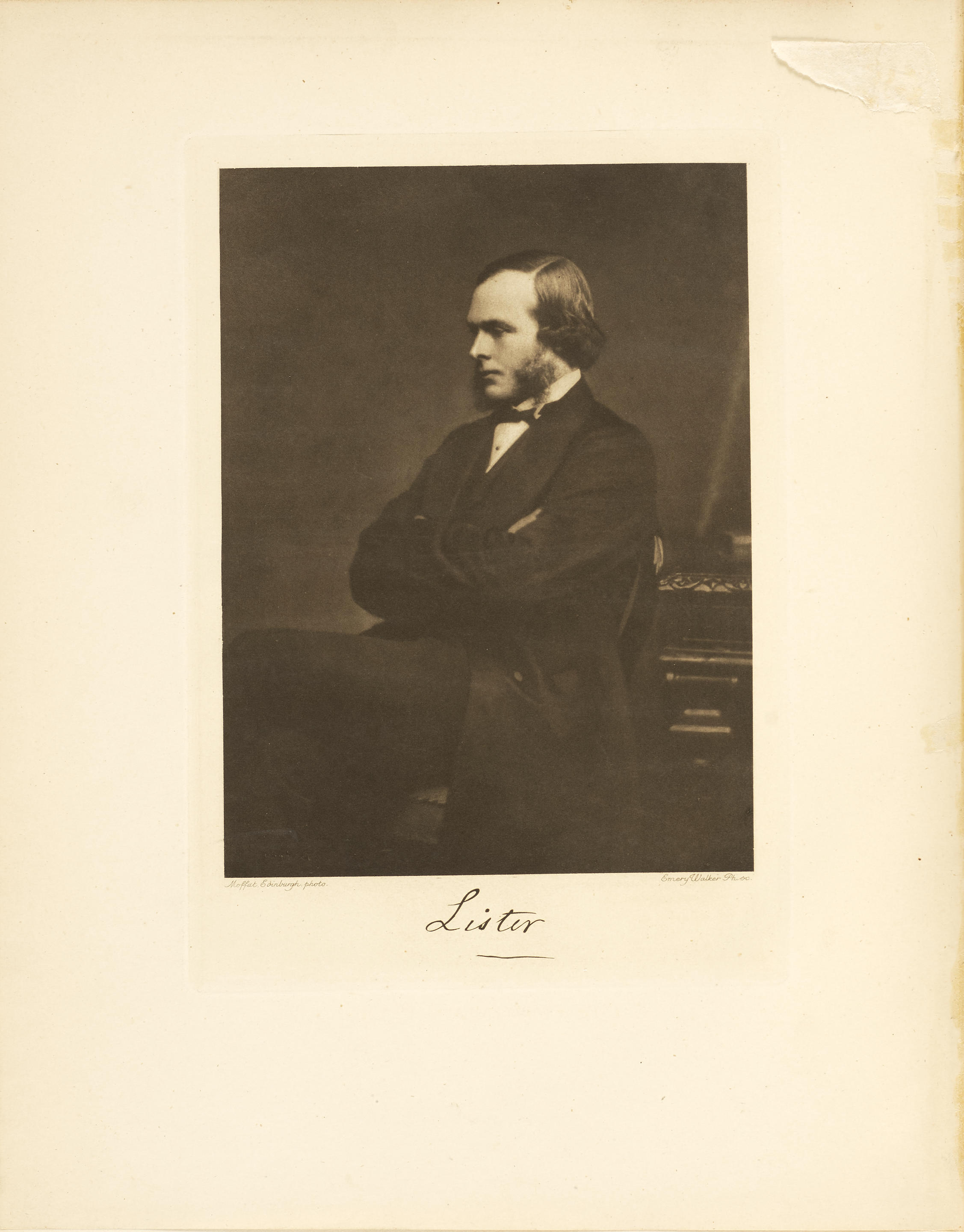LISTER, Joseph (1827-1912). "On a New Method of Treating Compound Fractures, Abscess, etc. With Observations on the Conditions of Suppuration". Extract from: The Lancet 1 (1867), pp. 326-329, 357-359, 387-389, 507-509, and 2 (1867), pp. 95-96. London: George Fall at the office of "The Lancet", [1857]. (268 x 192). The 10 extracted leaves with the journal title-leaf from vol. 1 and 6 index leaves from vol. 2. (Headlines to pp. 357-358 cropped.) Loose in original plain wrappers (disbound). Housed in folding cloth box with another extract and journal issues (see below). Provenance : Royal Artillery Medical Library (inkstamp). FIRST EDITION, journal issue, of the first of Lister's epoch-making papers on the antiseptic prevention of wound infection. In 1860 Lister was appointed Regius Professor of Surgery in Glasgow. As in other hospitals at that time, the mortality rate at Glasgow for amputations and compound fractures exceeded forty percent due to rampant infection. Lister had for some years been studying the processes of inflammation and suppuration, and in the early 1860's he "began declaring suppuration a form of decomposition. The prevailing medical doctrine about the cause of putrefaction derived from Liebig's dictum (1839) that organic substances in the moist state and in the presence of oxygen undergo a peculiar state of combustion" (DSB). The resulting supposition that wounds should be shielded from the effects of atmospheric oxygen led to often harmful treatments. "Lister realized that oxygen could not be excluded from wounds, and he soon doubted its responsibility for provoking suppuration" (op. cit.). In 1865 a colleague introduced him to the work of Pasteur, whose revelation of the causes of wound sepsis provided Lister "the key for the banishment of hospital diseases" (ibid.). "To prevent bacterial infection Lister began using carbolic acid, a chemical then used routinely by the city of Carlisle to disinfect sewage. In the series of surgical cases described in this landmark article in Lancet , he succeeded in completely eliminating infection. Although Lister was in error in assuming that the primary sources of infection were airborne, he had established the principle that the control of infection depended on the control of microorganisms" (Grolier Medicine ). The article also includes two important observations "on the healing capacities of tissues rendered uninfected by antiseptic treatment. First, a carbolized blood clot, left undisturbed, became organized into living tissue by ingrowth of cells and blood vessels from surrounding parts. Second, in an aseptic wound, portions of dead bone were absorbed by adjacent granulation tissue. Encouraged by these results, Lister began to apply the antiseptic principle to surgical wounds toward the end of 1866" (DSB). No offprints of Lister's important article have been recorded. Garrison-Morton 5634; Grolier Medicine 75; PMM316c; Norman 1366. [ With :] "On the Antiseptic Principle in the Practice of Surgery". Extract from: The Lancet 2 (1867), pp. 353-356. [London: George Fall 1857]. Disbound, with 14 other leaves from the same quire. FIRST EDITION, journal issue. In this second of Lister's two papers on antisepsis, read to the British Medical Association at their Dublin meeting of August 9, 1867, Lister announced that consistent application of his antiseptic treatment had entirely freed his Glasgow wards from hospital sepsis. After acknowledging his debt to Pasteur, he details his recommended procedures and describes further case histories of patients treated since publication of his previous articles. Like Semmelweis's recommendations for the implementation of aseptic hospital conditions a decade earlier, Lister's ideas initially encountered indifference or outright hostility in the surgical community, especially in Britain. Eventually a number of favorable reports, from German surgeons in particular, began to turn the tide, and by the eighties and nineties a return
LISTER, Joseph (1827-1912). "On a New Method of Treating Compound Fractures, Abscess, etc. With Observations on the Conditions of Suppuration". Extract from: The Lancet 1 (1867), pp. 326-329, 357-359, 387-389, 507-509, and 2 (1867), pp. 95-96. London: George Fall at the office of "The Lancet", [1857]. (268 x 192). The 10 extracted leaves with the journal title-leaf from vol. 1 and 6 index leaves from vol. 2. (Headlines to pp. 357-358 cropped.) Loose in original plain wrappers (disbound). Housed in folding cloth box with another extract and journal issues (see below). Provenance : Royal Artillery Medical Library (inkstamp). FIRST EDITION, journal issue, of the first of Lister's epoch-making papers on the antiseptic prevention of wound infection. In 1860 Lister was appointed Regius Professor of Surgery in Glasgow. As in other hospitals at that time, the mortality rate at Glasgow for amputations and compound fractures exceeded forty percent due to rampant infection. Lister had for some years been studying the processes of inflammation and suppuration, and in the early 1860's he "began declaring suppuration a form of decomposition. The prevailing medical doctrine about the cause of putrefaction derived from Liebig's dictum (1839) that organic substances in the moist state and in the presence of oxygen undergo a peculiar state of combustion" (DSB). The resulting supposition that wounds should be shielded from the effects of atmospheric oxygen led to often harmful treatments. "Lister realized that oxygen could not be excluded from wounds, and he soon doubted its responsibility for provoking suppuration" (op. cit.). In 1865 a colleague introduced him to the work of Pasteur, whose revelation of the causes of wound sepsis provided Lister "the key for the banishment of hospital diseases" (ibid.). "To prevent bacterial infection Lister began using carbolic acid, a chemical then used routinely by the city of Carlisle to disinfect sewage. In the series of surgical cases described in this landmark article in Lancet , he succeeded in completely eliminating infection. Although Lister was in error in assuming that the primary sources of infection were airborne, he had established the principle that the control of infection depended on the control of microorganisms" (Grolier Medicine ). The article also includes two important observations "on the healing capacities of tissues rendered uninfected by antiseptic treatment. First, a carbolized blood clot, left undisturbed, became organized into living tissue by ingrowth of cells and blood vessels from surrounding parts. Second, in an aseptic wound, portions of dead bone were absorbed by adjacent granulation tissue. Encouraged by these results, Lister began to apply the antiseptic principle to surgical wounds toward the end of 1866" (DSB). No offprints of Lister's important article have been recorded. Garrison-Morton 5634; Grolier Medicine 75; PMM316c; Norman 1366. [ With :] "On the Antiseptic Principle in the Practice of Surgery". Extract from: The Lancet 2 (1867), pp. 353-356. [London: George Fall 1857]. Disbound, with 14 other leaves from the same quire. FIRST EDITION, journal issue. In this second of Lister's two papers on antisepsis, read to the British Medical Association at their Dublin meeting of August 9, 1867, Lister announced that consistent application of his antiseptic treatment had entirely freed his Glasgow wards from hospital sepsis. After acknowledging his debt to Pasteur, he details his recommended procedures and describes further case histories of patients treated since publication of his previous articles. Like Semmelweis's recommendations for the implementation of aseptic hospital conditions a decade earlier, Lister's ideas initially encountered indifference or outright hostility in the surgical community, especially in Britain. Eventually a number of favorable reports, from German surgeons in particular, began to turn the tide, and by the eighties and nineties a return















Testen Sie LotSearch und seine Premium-Features 7 Tage - ohne Kosten!
Lassen Sie sich automatisch über neue Objekte in kommenden Auktionen benachrichtigen.
Suchauftrag anlegen